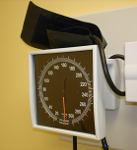What is Hypertension?
Author: tiger Published Under: Health

Hypertension is a serious condition that carries with it a number of very serious health risks. At its most basic, hypertension refers to a very high blood pressure level, which is considerably higher than average.
Before expanding on hypertension, it is important to understand a little bit about blood pressure and how it is measured.
What is Blood Pressure
In the body, blood is primarily contained inside of veins and blood vessels, which are basically like mini tubes, which extend to all of our appendages and tissue. As your heat beats, blood is sent coursing through your veins, brining important nutrients to even the most remote regions of your body, while also cleaning waste and helping to fight infection.
Blood Pressure is the pressure that is being exerted on the walls of our vessels as blood moves throughout the body. It is highest when your heart beats and subsequently relaxes slightly after each heart beat. Actions that require a great deal of energy, such as running or lifting weights, cause the heart to beat faster and raise blood pressure dramatically, only to drop again once the heart slows down.
To measure blood pressure, the most common method is to put an inflatable cuff over the arm of the patient, just above their elbow. A stethoscope is then placed under the cuff, which is inflated with air. As the cuff inflates, it temporarily cuts off the flow of blood into the major blood vessels in the arm.
By listening to the stethoscope as the air in the cuff is released, the doctor can hear the blood as it flows back into the main artery. There is a pressure gauge attached to the blood pressure cuff and the doctor will first note when they can hear blood flowing back into the artery, which is the systolic blood pressure. When the doctor can hear the heart beat again, they again make note of the number on the pressure gauge, which gives the Doctor the diastolic blood pressure. The blood pressure is then expressed in as the Systolic Blood Pressure / Diastolic Blood Pressure.
So, for example, if the doctor first heard the blood begin to flow back in at 115 and heard the heartbeat at 90, the person would have a blood pressure of 115/90, with the numbers representing the millimeters of mercury in the pressure gauge.
Typically, normal blood pressure is considered to be anything less than 120/80. Prehypertension, which is the state before hypertension, is 120/80 to 139/89. Hypertension begins after this and is divided into two stages.
Stage 1 Hypertension is 140/90 to 159/99, Stage 2 Hypertension is anything above 159/99.